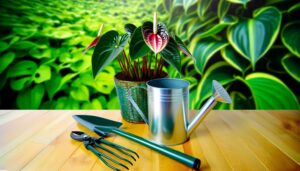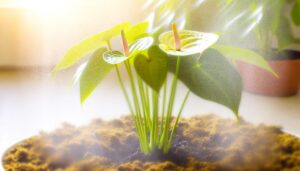Choosing the Perfect Type of Soil for Anthurium Plants
For thriving anthurium plants, choose a soil mix that includes pine bark, perlite, and peat moss. These components promote excellent drainage and aeration, preventing root rot and compaction.
Adding volcanic glass and orchid bark improves soil texture and stability. Charcoal and coconut coir further enhance aeration and structure.
Aim for a soil pH between 5.5 and 6.5 to maximize nutrient absorption. Balancing organic matter like peat moss with inorganic elements such as perlite ensures a strong growing environment.
Managing components to maintain the right blend will support healthy growth and blooming. Discover more nuanced tips for your anthurium’s best soil conditions.

Key Takeaways
- Ensure the soil mix includes pine bark, perlite, and peat moss for optimal growth.
- Incorporate charcoal and coconut coir to improve soil structure and aeration.
- Maintain soil pH levels between 5.5 and 6.5 for ideal nutrient absorption.
- Use a balance of organic and inorganic materials to enhance drainage and stability.
- Include peat moss and perlite to provide water retention and aeration.
Understanding Anthurium Soil Needs
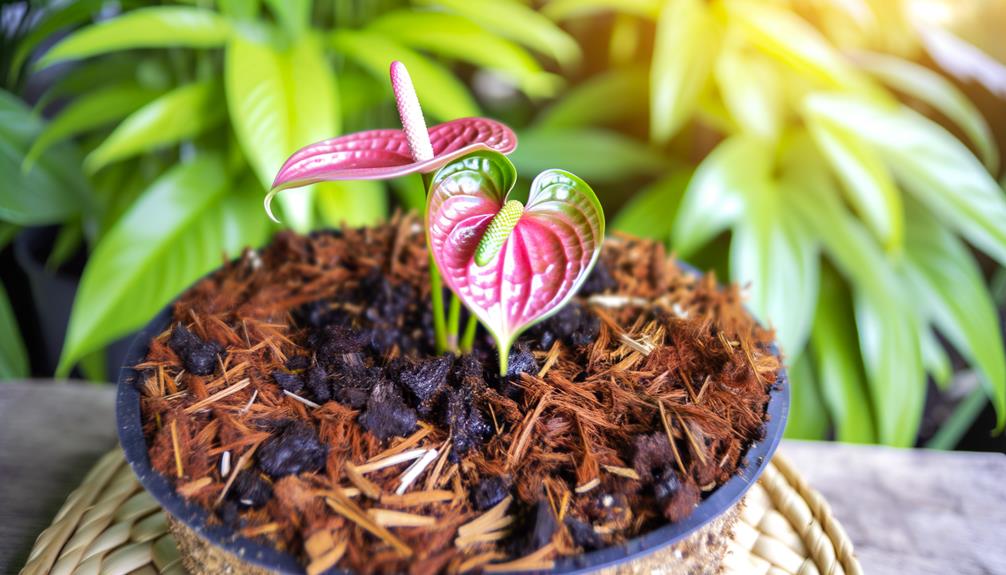
To understand anthurium soil needs, you must recognize that these tropical plants thrive in well-draining, aerated soil that mimics their natural rainforest habitat. You should aim for a mix containing materials like pine bark, perlite, and peat moss.
Pine bark maintains the soil’s looseness, allowing roots to breathe. Perlite aids in drainage, preventing water from stagnating. Peat moss retains moisture without waterlogging the plant.
For peak growth, maintain a slightly acidic pH level, ideally between 5.5 and 6.5. Include organic matter to provide essential nutrients.
By carefully selecting and combining these components, you’ll create an environment where anthuriums can flourish, showcasing their vibrant blooms and lush foliage.
This approach ensures you’re meeting their specific needs effectively.
Importance of Proper Drainage
Proper drainage is essential for your Anthurium plants as it prevents root rot by ensuring excess water doesn’t linger around the roots.
It also enhances oxygen flow, which is important for root respiration and overall plant health.
Additionally, good drainage reduces soil compaction, allowing roots to grow more freely and absorb nutrients effectively.
Prevents Root Rot
One of the most important aspects of maintaining healthy anthurium plants is ensuring the soil has sufficient drainage to prevent root rot.
Root rot occurs when roots sit in waterlogged soil, depriving them of essential oxygen and promoting fungal growth.
To combat this, use a well-draining mix rich in organic matter like orchid bark, perlite, and peat moss.
These components help maintain moisture without retaining excess water. Additionally, make sure your pots have drainage holes, allowing excess water to escape.
Regularly check the soil’s moisture levels and adjust watering schedules accordingly. By taking these precautions, you’ll create an ideal environment for your anthurium plants, ensuring their roots stay healthy and strong, thereby supporting vibrant growth and longevity.
Enhances Oxygen Flow
Ensuring proper drainage is essential for enhancing oxygen flow to the roots of your anthurium plants, which is important for their overall health and development. Oxygen-rich soil supports root respiration, allowing plants to absorb nutrients efficiently.
To achieve ideal drainage, consider the following:
- Choose a well-aerated soil mix: Incorporate materials like perlite, orchid bark, and peat moss to promote airflow.
- Use pots with drainage holes: This prevents water from accumulating at the bottom, reducing the risk of waterlogging.
- Avoid compacted soil: Loose soil helps maintain air pockets, ensuring roots can breathe.
- Water correctly: Water thoroughly but allow the soil to dry out slightly between waterings.
Reduces Soil Compaction
Reducing soil compaction is vital for maintaining proper drainage, as compacted soil can restrict root growth and reduce the plant’s ability to absorb water and nutrients effectively.
To make sure your Anthurium plants thrive, you need to choose a well-aerated soil mix that includes components like perlite, pine bark, and coconut coir. These elements help create air pockets, allowing roots to breathe and water to drain efficiently.
Avoid heavy, clay-based soils, as they tend to compact and hold excess moisture, leading to root rot. Regularly check the soil’s texture and consider gently loosening it if compaction occurs.
Soil Aeration Essentials
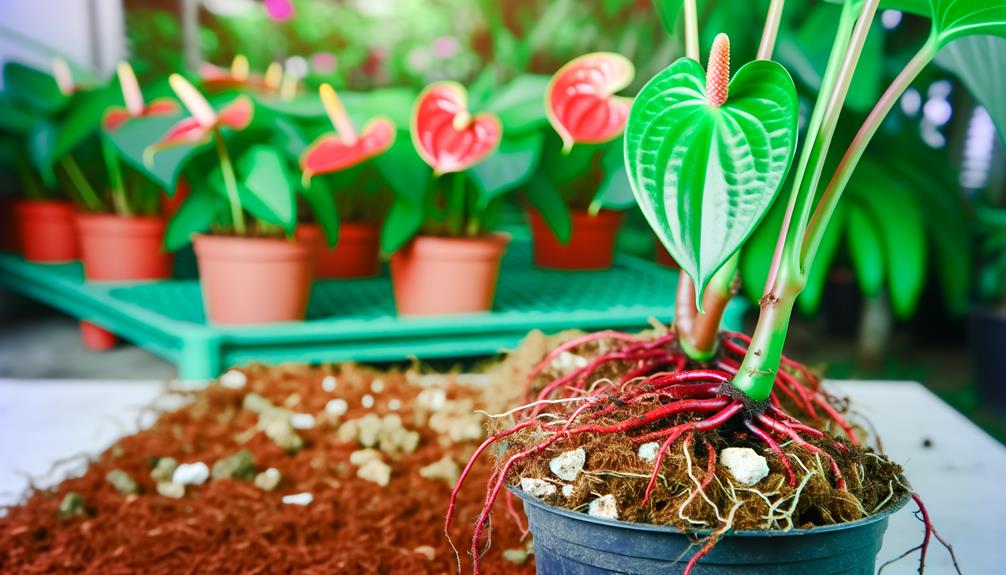
To guarantee your Anthurium plants thrive, you must prioritize soil aeration by creating ample air pockets. These pockets facilitate root respiration and nutrient absorption, essential for healthy growth.
Additionally, regularly check and adjust the soil to prevent compaction, which can obstruct airflow and hinder root development.
Importance of Air Pockets
Understanding the importance of air pockets in soil is key for maintaining the health and vitality of your Anthurium plants. Air pockets promote proper soil aeration, allowing roots to breathe and absorb nutrients effectively.
Without sufficient aeration, your plants may suffer from root rot and other diseases. Here’s why air pockets are essential:
- Enhanced Root Respiration: Roots need oxygen to function, and air pockets provide that important oxygen.
- Efficient Nutrient Uptake: Properly aerated soil helps roots absorb nutrients more effectively.
- Disease Prevention: Good aeration prevents waterlogging, reducing the risk of fungal infections.
- Healthy Microbial Activity: Beneficial microbes thrive in aerated soil, contributing to overall plant health.
Preventing Soil Compaction
Maintaining soil aeration is essential for preventing compaction, which can severely hinder the growth and health of your Anthurium plants.
To achieve this, consider using a well-draining mix that includes components like perlite, orchid bark, and peat moss. These elements provide the necessary air pockets, ensuring roots receive adequate oxygen.
Regularly check the moisture levels to avoid overwatering, as excess water can lead to compacted soil. Gently loosening the top layer of soil periodically also helps maintain aeration.
Additionally, avoid pressing down firmly when potting your Anthuriums. If you’re repotting, choose a slightly larger pot to give roots more room to breathe.
Nutrient Retention Factors
Nutrient retention in soil is vital for anthurium plants because it ensures that essential minerals like nitrogen, phosphorus, and potassium are readily available for optimal growth. When selecting soil, focus on its ability to retain nutrients. This guarantees your anthuriums thrive and display vibrant foliage and blooms.
Consider the following factors:
- Cation Exchange Capacity (CEC): A high CEC indicates the soil retains nutrients effectively, making them accessible to your plants.
- Soil Texture: Mixtures with a blend of sand, silt, and clay offer excellent nutrient retention.
- pH Levels: Aim for a slightly acidic pH (5.5-6.5) to enhance nutrient availability.
- Water Retention: Proper moisture levels assist in the dissolution and efficient absorption of nutrients.
Organic Vs. Inorganic Components
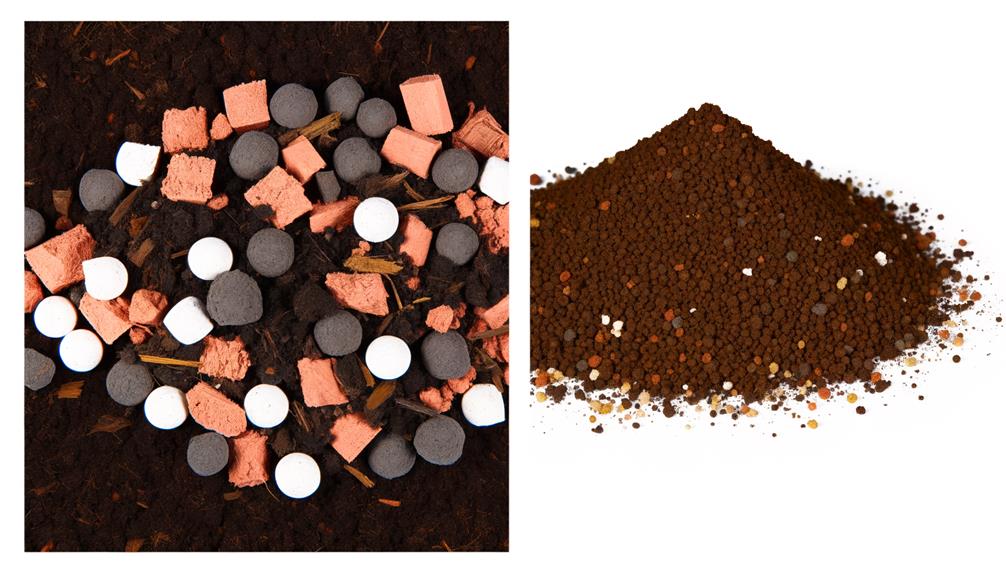
When selecting soil for your Anthurium plants, consider the advantages of both organic nutrient sources and inorganic soil amendments.
Organic components like compost and peat moss provide essential nutrients and improve soil structure, while inorganic materials such as perlite and vermiculite enhance drainage and aeration.
Balancing these elements guarantees ideal growth and health for your plants.
Organic Nutrient Sources
To maximize growth for your anthurium plants, you need to understand the distinct advantages of organic nutrient sources compared to inorganic components.
Organic sources like compost, worm castings, and peat moss enhance soil structure and promote beneficial microbial activity. They also release nutrients slowly, providing a steady supply for your plants.
Consider these benefits of organic components:
- Improved Soil Aeration: Organic matter increases porosity, ensuring roots get enough oxygen.
- Enhanced Water Retention: It helps soil retain moisture, reducing the need for frequent watering.
- Sustainable Practices: Using organic materials supports eco-friendly gardening.
- Microbial Health: Organic nutrients foster beneficial microorganisms, essential for nutrient cycling and disease prevention.
Inorganic Soil Amendments
While organic nutrient sources offer numerous benefits, don’t overlook the role inorganic soil amendments play in enhancing the growing conditions for your anthurium plants. Perlite, a volcanic glass, improves aeration and drainage, which are essential for preventing root rot.
Vermiculite, a hydrated silicate mineral, retains moisture and nutrients, ensuring consistent hydration. Sand enhances soil structure, contributing to ideal root development. These inorganic components provide stability and consistency that organic materials sometimes lack.
When you blend them with organic matter, you create a balanced environment that supports strong growth. By understanding their specific functions, you can tailor your soil mix to meet the unique needs of your anthurium plants, ensuring they thrive and flourish.
Ideal Ph Levels
Finding the best pH level for anthurium plants is crucial, as they thrive most in slightly acidic soil with a pH range of 5.5 to 6.5. Ensuring this pH range can be the difference between a flourishing anthurium and a struggling one.
To achieve this:
- Test your soil’s pH: Use a dependable soil pH tester to monitor levels accurately.
- Adjust pH as needed: Add sulfur to lower pH or lime to raise it.
- Monitor regularly: Check soil pH every few weeks to maintain the most favorable conditions.
- Use distilled water: Tap water can change pH; distilled water keeps levels stable.
Choosing Potting Mixes
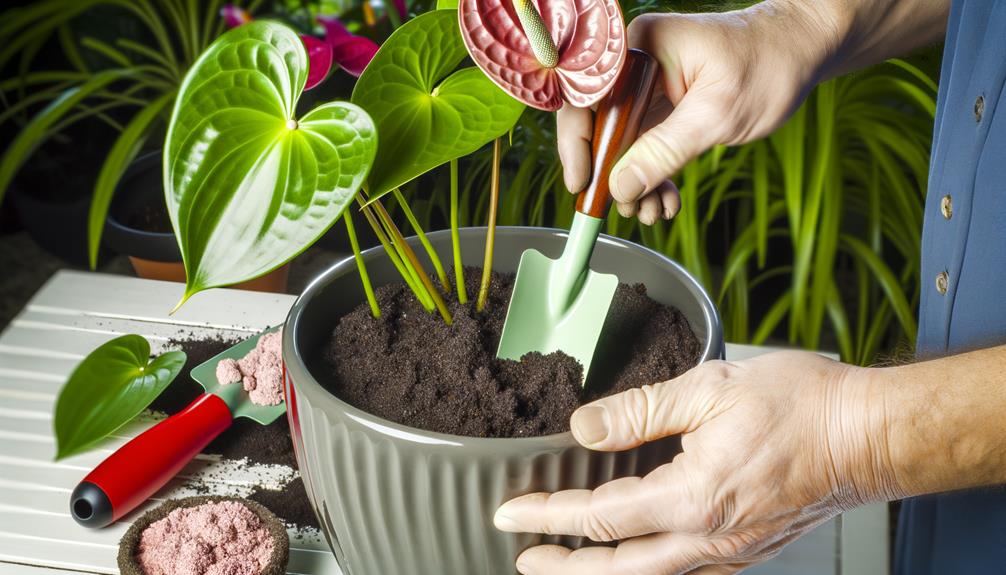
Choosing the correct potting mix for anthurium plants is essential, as a well-draining, aerated medium guarantees peak root health and growth.
You’ll need a combination of ingredients to achieve the perfect balance of moisture retention and aeration. A mix containing orchid bark, perlite, and charcoal works well.
Here’s a quick reference table to guide you:
| Ingredient | Purpose |
|---|---|
| Orchid Bark | Provides aeration and structure |
| Perlite | Enhances drainage and prevents compaction |
| Charcoal | Improves aeration and removes toxins |
| Pine Bark | Retains moisture while aiding drainage |
Benefits of Peat Moss
Peat moss offers great moisture retention and a slightly acidic pH, making it a perfect component for anthurium potting mixes. Its ability to maintain a consistent level of humidity around the roots ensures your anthurium gets sufficient hydration.
Here are four benefits of using peat moss:
- Outstanding Water Retention: Peat moss holds water, reducing the frequency of watering.
- Rich in Nutrients: It supports nutrient absorption, promoting healthy growth.
- Aeration: It enhances soil structure, allowing roots to breathe.
- Slightly Acidic pH: This matches anthuriums’ preference, creating an ideal growing environment.
Incorporating Perlite
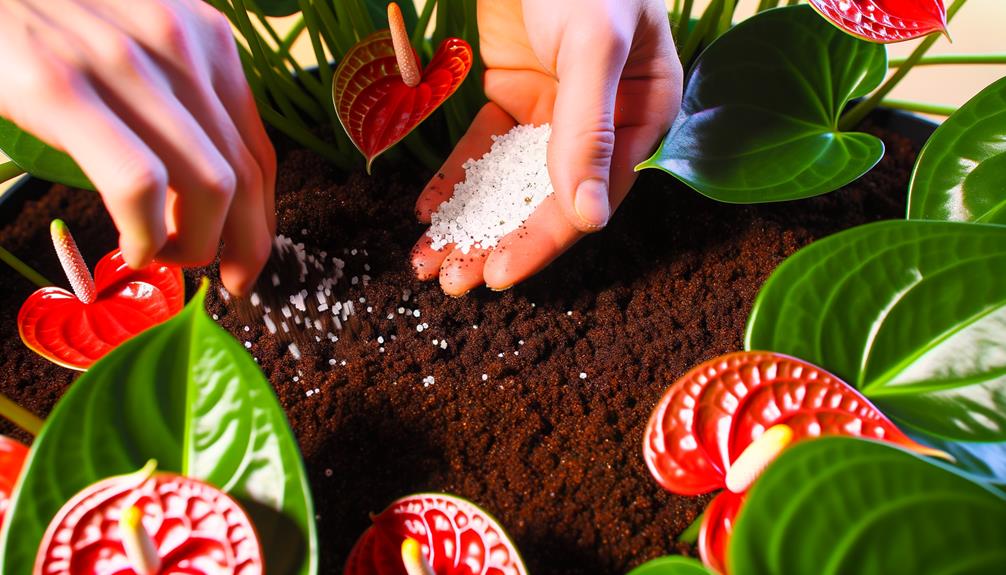
To further optimize your anthurium’s soil, incorporating perlite can greatly enhance drainage and prevent root rot. Perlite is a volcanic glass that, when heated, expands to create a lightweight, porous material.
Mixing perlite into your soil blend increases aeration, ensuring your anthurium’s roots receive adequate oxygen. Aim for a soil mix with about 20-30% perlite.
This component helps maintain a balanced moisture level, essential for anthuriums, which thrive in well-draining environments.
By using perlite, you’re not only improving soil structure but also promoting healthier root systems. Remember, well-drained soil reduces the risk of fungal infections, providing your plant a robust growing foundation.
Incorporating perlite is a practical step towards creating the ideal conditions for your anthurium.
Coconut Coir Advantages
Coconut coir, derived from the fibrous husk of coconuts, offers remarkable water retention and aeration properties, making it an excellent addition to your anthurium’s soil mix.
You’ll find that coconut coir supports your plant’s health by providing a balanced moisture environment, reducing the risk of root rot and encouraging robust growth. It’s also a sustainable choice, which aligns with your commitment to eco-friendly gardening.
Consider these benefits:
- Water Retention: Keeps your anthuriums hydrated without waterlogging.
- Aeration: Promotes healthy root growth by ensuring adequate airflow.
- pH Neutral: Provides a stable environment for nutrient uptake.
- Sustainability: Helps reduce your environmental footprint.
Incorporating coconut coir will enhance your plant care efforts, fostering vibrant and thriving anthuriums.
Avoiding Common Soil Mistakes
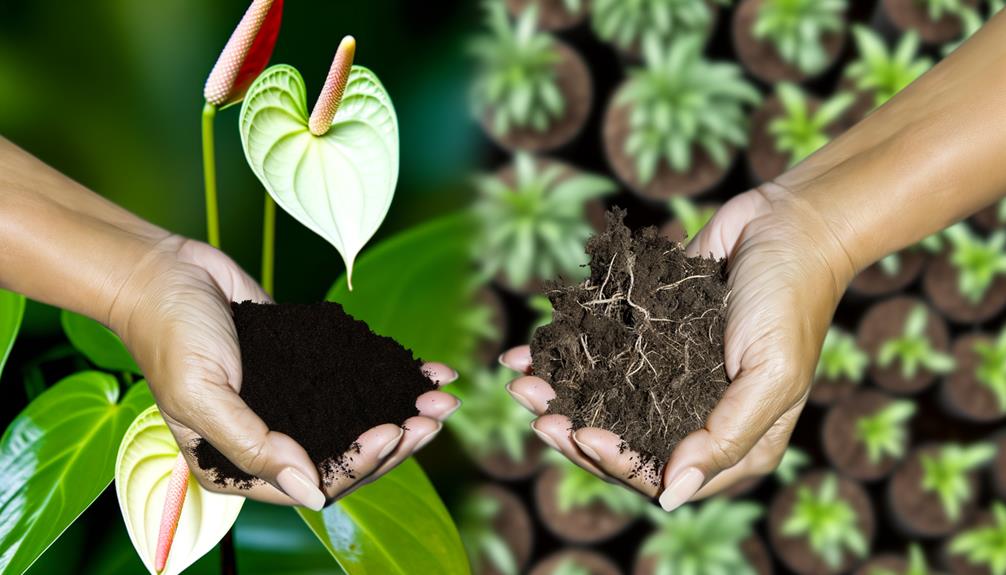
Understanding and avoiding common soil mistakes is crucial for ensuring your anthuriums flourish and remain healthy.
First, avoid using heavy, clay-based soils, as they retain too much moisture, leading to root rot. Instead, choose a well-draining mix.
Over-fertilization is another common error; excessive nutrients can burn the roots and stunt growth. Stick to a balanced, slow-release fertilizer and apply it sparingly.
Additionally, avoid compacting the soil when potting, as it restricts airflow and water drainage.
Lastly, don’t ignore pH levels. Anthuriums prefer a slightly acidic to neutral pH (5.5-6.5). Regularly test your soil’s pH and adjust if necessary.
Creating Your Own Mix
Crafting your own soil mix for anthuriums guarantees you can tailor the medium to meet the specific needs of these tropical plants. Start by ensuring the mix is well-draining, rich in organic matter, and slightly acidic.
Here’s a reliable recipe to get you started:
- Orchid Bark (40%): Provides excellent drainage and aeration.
- Peat Moss (30%): Retains moisture without becoming waterlogged.
- Perlite (20%): Enhances drainage and prevents soil compaction.
- Charcoal (10%): Absorbs impurities and improves soil structure.
Conclusion
You’ve now got the lowdown on selecting the perfect soil for your anthurium plants. Remember, a well-drained, aerated mix with balanced nutrients is key.
Don’t shy away from blending organic and inorganic components like coconut coir and perlite. Avoid common pitfalls, and you’ll have your anthuriums thriving.
Ultimately, creating your own mix lets you tailor it to your plant’s needs. So, roll up your sleeves and get your hands dirty—your anthuriums will thank you for it!




